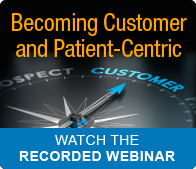Lately in our Change Management Consulting work, we are seeing a lot of organizations who are strategically hoping to become customer-centric-- or for those of our clients in the health care industry, patient-centric. Simply put, these organizations are making changes to their inherent culture to make their primary focus the customer they are serving rather than the product they are trying to sell. 
From a buyer and consumer perspective, working with an organization that is customer-centric can only be a good thing. Having your voice heard is invaluable. From an organizational point of view, there is clearly a lot of value in doing a better job of listening to the voice of the customer, and designing processes that are intended to build customer satisfaction.
But if you are like many organizations, you may be asking yourself what the best way is to actually implement customer-centric strategies. Is it just a question of making a few incremental improvements in how things are done? Or does becoming customer-centric require transformational change in the organization?
Transformational Change
There is no doubt in our minds that changing to a customer/patient-centric model is transformational. This type of change demands your entire organization do different things in different ways. People, processes and technology will all be significantly impacted, thus, defining the change as transformational.
Like most transformational changes, moving to a customer/patient centric model will not be easy. In order for your organization to implement this new venture successfully, there are 5 metrics that must be met:
- On Time
- On Budget
- All Technical Objectives Met
- All Business Objectives Met
- All Human Objectives Met
To achieve these 5 objectives, our change management consultants recommend following 5 basic steps using a structured repeatable implementation process like AIM.
5 Steps to Ensure Transformational Change Success
- Define the Change. The starting point for every change management project should be a clear, compelling definition of the change. Your definition must identify the behavior gap between the current state and the future state.
- Sustained, Active Sponsorship Needs to be Present. Securing Active Sponsors is by far, your biggest challenge, and biggest opportunity for acceleration. The fastest way to transform is by having them change the way in which they lead the organization, most importantly with their own direct reports.
- You Must Completely Re-think Your Reinforcement System. Reinforcement is not just your performance appraisal process or pay and compensation. Leaders reinforce all day long, every day. You can’t continue to reinforce the same old values and behaviors in your organization and expect to change your culture!
- Sponsors Must Pay a Personal Cost - There must be some overt and demonstrable change in leader behavior that signifies a sacrifice on the part of that sponsor. Otherwise it appears that the transformation is for everyone else in the organization, but not for the people who live in “Mahogany Row.”
- Anticipate the Most Resistance from Your Sponsors. The highest levels of resistance come from the individuals with the highest vested interest in things remaining the same. Many times, the people you actually seek to Sponsor the transformation, and who have the most impact on driving the transformation, also have the most resistance because you are asking them to fly in the face of their previous success!
Tips
Following the above 5 steps will ensure you are well on your way to implementation success. However, here are a few more tips and best practices when launching customer/patient centricity:
- Have customer-focused measures in place from the very start.

- Don’t launch any vision statements unless you know how you are going to model and reinforce the new behaviors.
- Ensure there is absolute alignment in what Sponsors say, what they do, and what they reinforce around customer-centricity.
- Model good customer service practices with your internal customers before you can expect to see changes in customer experiences externally.
- The more often you measure customer/patient centric behavior, with immediate positive and negative reinforcement attached…the faster you can implement.
If your organization is thinking about becoming customer/patient-centric, remember, it’s a transformational change that requires more than just a power-point presentation on what good customer service looks like. Get ready to roll up your sleeves and dig deep as you are inherently changing the culture of your organization.



